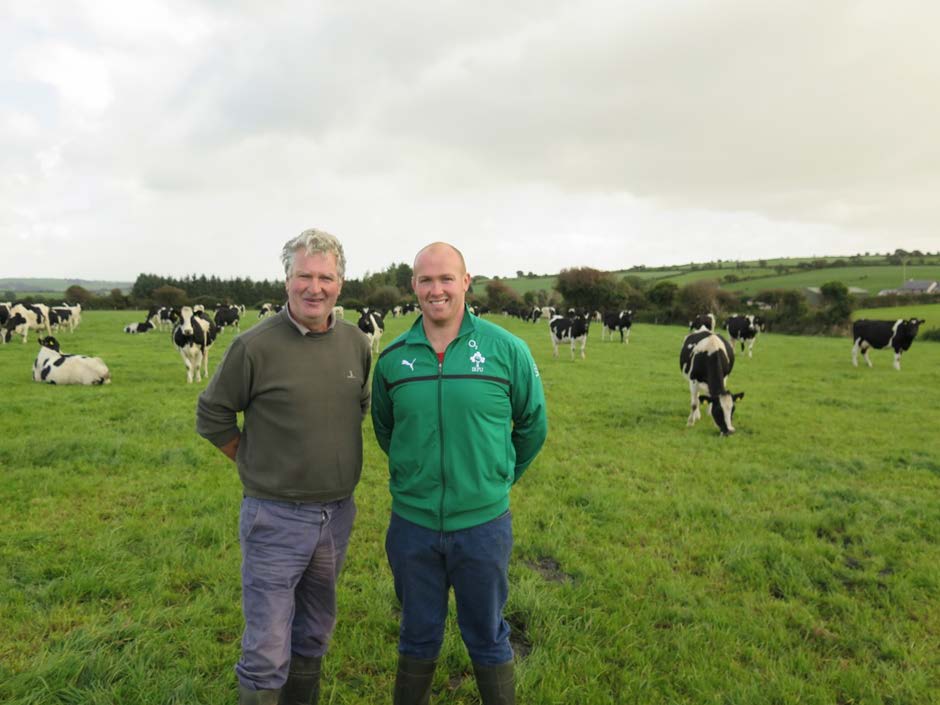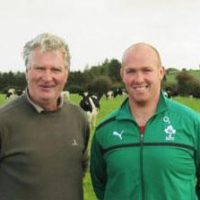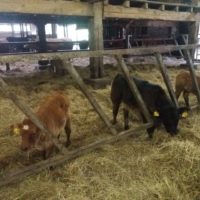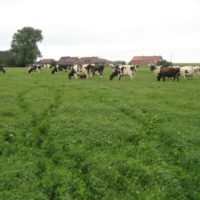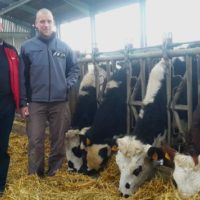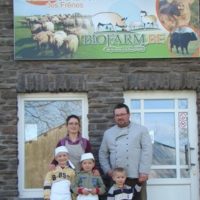Grassland innovation: Grazing monocultures to increase grass production and utilisation
Farm: “Tim Crowley”
Location: Bandon, Co. Cork, Ireland
Case study
 Grassland innovation: Grazing monocultures to increase grass production and utilisation (.pdf)
Grassland innovation: Grazing monocultures to increase grass production and utilisation (.pdf)
Description
Background
Farm Performance
Timmy and his father Dan Crowley are farming 82ha of land of which 33ha is leased. Since quotas were abolished in 2015 herd size has increased from 90 cows to 150 cows today with a plan to milk 180 cows in 2019. The purchase of 15ha of land on the milking block in 2017 allowed Timmy to increase his milking platform to 59ha. Currently there is a stocking rate of 2.52cows/ha on the milking block and next year Timmy will push this to a stocking rate of 3cows/ha based on his production of grass.
This focus of output and profit on this farm is stemmed from high grass utilization. Timmy fed 680kgs meal/cow in 2017 and the rest of the herds’ diet was made up of grazed grass and grass silage. Timmy sold 422kgs milk solids/cow to the co-op in 2017 or 1122kkgs/ha. The target is to sell 1350kgs/ha of milk solids from a predominately grazed grass diet. With a strong focus on high grass utilization on this farm, Timmy’s total costs for 2017 were 16.6c/litre with a Dairy Output of 39.1c/litre.
As with high grass utilization good herd genetics has also a role to play in the high performance of this farm. The herd EBI of this black and white herd is €113. Calving interval was 367days in 2017 and the six week calving rate has hovered around 80% the last five years. Compact calving is key to profitability where Timmy can get high numbers of cows to grass early in the spring, which increases the value of milk sales and reduces feed costs. Getting high volumes of cows out to grass in February is first key step to achieving ten rotations.
Detailed description
Investing in Grazing
In order for expansion to be successful, there will be a requirement for significant investment on many farms. The available capital for this investment will be a scarce as expansion happens and continues. Therefore, investment on farm should be prioritised at areas that increase efficiency and reduce the exposure of the business to external shocks such as lower price of product or higher price of inputs etc. All investments that give the highest returns should be prioritised.
Every ton of additional grass eaten by the grazing animal will add €180/ha additional profit to a dairy farm. Therefore it is important that investment in grazing is prioritised to give the maximum return. The table below summarises the potential return on investment for different investments in a dairy farm business. Bottom Line: The level of return to these investments is high because it is investing in grazing. These investments will either enable the farm to grow more grass or lengthen the grazing season or both.
The need for more reseeding
As grass is our main feed during the main grazing season, and the primary source of winter forage in the form of grass silage, the low level of reseeding must be addressed. Reseeding must be combined with managing, and where necessary increasing, soil fertility. Ireland will continue to increase milk production and the focus on efficient production of this milk is critical to maintain our industry competitiveness. Teagasc have developed a national grassland database (PastureBaseIreland), and the initial results show that there is huge capacity on Irish farms to grow more grass. The objective of this handbook is to outline the key points in grassland reseeding and to ensure farmers making the investment in renovating grassland get the best possible result.
Why reseed?
Productive grassland farms must have perennial ryegrass dominated swards. Recent Moorepark research shows that old permanent pasture produces, on average, 3 t DM/ha per year less than perennial ryegrass dominated swards. Old permanent pasture is up to 25% less responsive to available nutrients such as nitrogen than a perennial ryegrass dominated sward. Reseeding is a highly cost effective investment. With regular reseeding the grass growth capacity of the farm can be increased substantially and the annual return of investment is large.
Adoption criteria
Variety choice
The DAFM publish the recommended list, showing the Pasture Profit Index values and agronomic values of the evaluation on the same table (see www.teagasc.ie/crops/grassland/pasture-profit-index/).
The Recommended List has evaluated varieties across years and sites and is the only evidence available of the potential performance of grass cultivars in Ireland. Using varieties not on this list is basically poor decision making, as is buying grass seed on price. The varieties you use on the farm, will be there for 8-12 years, choosing to use cheap mixes, with non-recommended varieties will increase the chances of those varieties failing to perform on the farm.
When the decision to reseed is made, the next major decision is selecting the most appropriate grass variety or varieties. The first thing to consider is the primary target use of the field. Is it predominantly grazing or is it generally used as a silage paddock? How much tetraploid should be used? A balance between quality, dry matter productivity and sward density is generally what must be achieved.
The key traits in a seasonal grass based production system are:
- High quality
- High seasonal production
- Good persistency score
Differences between diploid and tetraploid varieties
Tetraploid varieties
- Tall upright growth habit
- Prostrate growth habit
- Create more ‘open’ sward
Diploid varieties
- Create a denser sward with less “open” spaces
- Higher digestibility value
- Generally lower digestibility and yield
Combining diploids and tetraploids in a mixture will create a dense, high quality sward – ensure you select varieties which express high performance in the key traits. Increasing the proportion of diploids on heavier soils is recommended to create better ground cover, however tetraploids should be used on heavy soils. Choosing all dense varieties will compromise DM production and grazing utilisation.
Key points when choosing a variety:
- Decide what the end use is – grazing or silage – formulate based on this
- Focus on the key traits increase the proportion of the varieties with the key traits
- Sow 35 kg/ha (14 kg/ac) of seed
- Less than 7 days range in heading date between varieties
- Grazing specific mixtures
- Varieties exhibiting high seasonal (Spring and Autumn) PPI values
- Varieties with high quality sub index values
- Silage specific mixtures, e.g. 2-cut system
- Varieties which have high silage sub index values
- Ensure proximity of heading dates
- Avoid low silage sub index diploids and poorly persistent tetraploids
Future prospects
Productive grassland farms must have perennial ryegrass dominated swards. Recent Moorepark research shows that old permanent pasture produces, on average, 3 t DM/ha per year less than perennial ryegrass dominated swards. Old permanent pasture is up to 25% less responsive to available nutrients such as nitrogen than a perennial ryegrass dominated sward. Reseeding is a highly cost effective investment. With regular reseeding the grass growth capacity of the farm can be increased substantially and the annual return of investment is large.
Additional information
| Farming system | conventional farming |
|---|---|
| Domains of innovation | farm system, forage mixture, grazing management system |
| Main types of animal | dairy cattle |
| Country | Ireland |
| Product type | Case study |
| Language | English |

